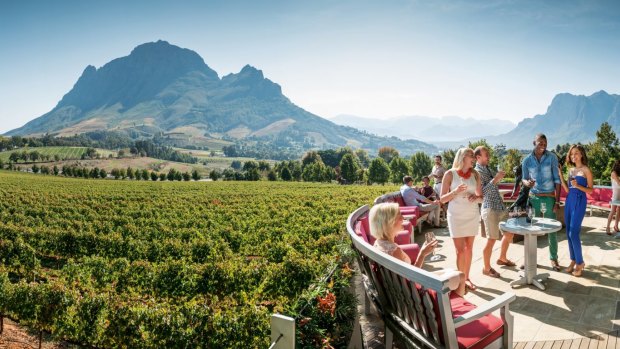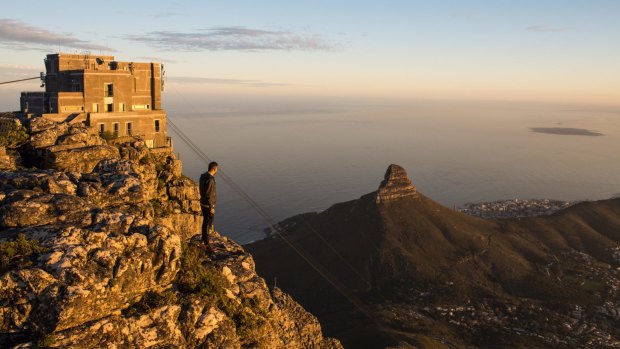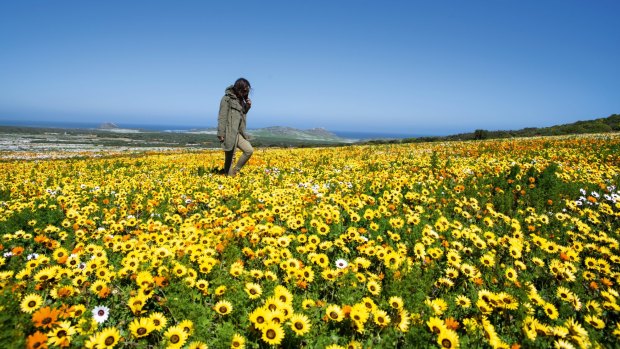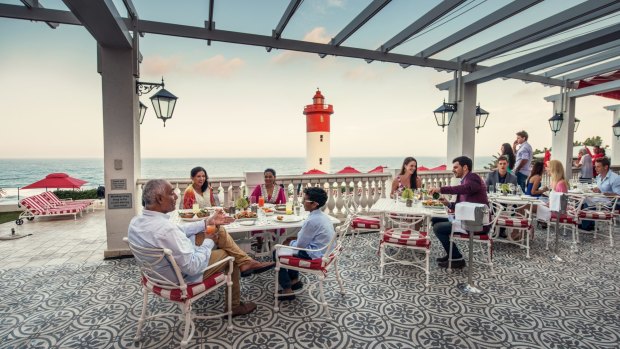This was published 5 years ago
South Africa travel guide: Six off-the-beaten-track tourism highlights

A vineyard in the Western Cape.
Jan van Riebeeck is staring down at me from the side of a building in the old suburb of Jeppestown, Johannesburg. He's the same guy from the banknotes and the history textbooks of my South African childhood – jaunty moustache, wavy hair – but he's been spruced up for the 21st century: his jacket is imprinted with mobile phones and golden apples and hot-pink sketches of the Dromedaris, the ship on which he sailed from the Netherlands to the Cape of Good Hope, founding Cape Town in 1652.
I bump into Nelson Mandela a few blocks away. His body unfurls the entire length of a 40-metre-high block of flats, shoulders hunched in a boxing pose, eyes fixed on something only he can see. He is a young man still, with a lifetime of struggle awaiting him.
I peer up at him and consider this absurd fact: unlike van Riebeeck's familiar face, I had no idea what Mandela looked like while I was growing up, for he'd been imprisoned before I was born (in a maternity hospital just down the road from here) and his image was strictly banned from publication.

Looking out over Cape Town and Lion's Head from Table Mountain.
The first most South Africans saw of those gentle, stately, now-burned-onto-the-retina features was upon his release in 1990. How things have changed. Madiba is everywhere these days, on T-shirts and murals and pasted (in van Riebeeck's stead) across the country's banknotes.
His spirit, too, seems to infuse the streets of old Jeppestown – a no-go zone of industrial blocks and nefarious goings-on in my youth, now rebirthed as the Maboneng Precinct, an inner-city hub whose name, in Sesotho, means "place of light". This is a neighbourhood permeated with the playfulness and joie de vivre so emblematic of Mandela, and so lacking during the dark years of apartheid.
Squatters have stayed on in some of these buildings – crime, entrenched poverty and corruption are issues that plague the country still. But the ghetto has been humanised, its residents supported by the community (rather than discarded by the process of gentrification), its demographic rebalanced with an influx of socio-economically divergent people who commonly embrace integrated inner-city living.

The West Coast National Park.
Refurbished buildings hum with new life: businesses and social enterprises, galleries such as Arts on Main (Maboneng's genesis) and the Museum of African Design, moody jazz lounges and bright cocktail bars, and restaurants reflecting the melting pot of tastes that blend to form South African cuisine.
It's a microcosm of the new South Africa Mandela could once only dream of: an old district forging a bold new identity with optimistic, sometimes messy strides; an African concrete jungle splashed in all the colours of his beloved Rainbow nation.
But South Africa is more than the sum of its most famous parts, such as Cape Town, Kruger National Park and Durban. It's almost 2800 kilometres of coastline rimmed with spectacularly beautiful, untouched beaches, a hinterland buckled with mountain ranges and sapped by desert plains, and a soul vivified by the long, shared struggle for freedom.

Oyster Box restaurant in Durban.
Here's how to expand your knowledge and experience Madiba's Rainbow nation by swapping the country's household names with some of its lesser known gems.
INSTEAD OF CAPE TOWN TRY PORT ELIZABETH
Cape Town is the supermodel of the multi-talented South African family: beautiful, seductive and charismatic in a way that will blind you to her sister-cities' less flirtatious charms.
And while no other South African city can match that sublime mountain backdrop, Port Elizabeth in the Eastern Cape (the country's second oldest city after Cape Town) possesses beauty of its own, set as it is upon the broad turquoise sweep of dolphin-and-whale-filled Algoa Bay.
Known variously as the Windy City, the Friendly City, PE or Nelson Mandela Bay (the bigger municipal metropolitan area incorporating outlying towns), Port Elizabeth has long been the thoroughfare to Addo Elephant Park, Mount Zebra National Park, the Karoo and seaside villages such as Jeffreys Bay (where Australian surfer Mick Fanning notoriously encountered a shark during the J-Bay Open World Surf League event in 2015).
It's also sometimes the starting or ending point for the Garden Route. But a recent urban regeneration has established PE as a destination in its own right: creatives are flooding back into the city's historic centre; microbreweries are flourishing in formerly rundown warehouses; galleries, museums, wine bars and restaurants are springing up in the city and along Nelson Mandela Bay's 40-kilometre coastal belt, which is dotted with protected swimming beaches.
Get your historical bearings on the Donkin Heritage Trail, which traces the city's Victorian landmarks; and unearth the city's British and African origins and its experience of the 1994 elections on Route 67, an art and heritage trail commemorating the precise number of years Mandela dedicated to public life with 67 individual works by Eastern Cape artists. The Nelson Mandela Bay Pass offers access to a wealth of sites and activities in the region. See nelsonmandelabaypass.co.za
INSTEAD OF KRUGER NATIONAL PARK TRY PILANSBERG NATIONAL PARK
South Africa's reputation as a safari destination was cemented in the sprawling, 92-year-old Kruger National Park (which started life as Sabi Game Reserve in 1898) and the collection of luxury lodges scattered inside its borders and along its perimeter.
This protected wilderness bordering Zimbabwe and Mozambique in South Africa's north-east feels quintessentially African: crackling veld; savannahs dotted with flat-topped thorn trees; wildlife – elephant, lion, leopards, impala so bountiful one eventually tires of them – roaming unfettered through a magical kingdom.
But there's a rival for this old favourite, and it's growing in popularity among both local and foreign visitors. Located in ridge-fringed caldera and set in a transitional zone between the Kalahari Desert and the Lowveld, the Pilansberg is a habitat for all of southern Africa's animal species – including the Big Five (elephant, black rhino, leopard, buffalo and lion) and a superfluity of birds.
Less common antelope such as roan, tsessebe and sable congregate here, too, along with every safari-goer's dream sighting, painted dogs (or wild dogs). The park is also filled with rare geological formations and Iron Age and Stone Age sites.
The upsides to visiting Pilansberg are multiple: it's only a three-hour drive from Johannesburg and is located in a malaria-free zone; its comparatively small size and high game density guarantees satisfying wildlife encounters; it offers a range of accommodation, from camping and self-catering to exclusive-use lodges; and for those keen on some post-safari poolside R&R, golfing, glitzy gambling or live entertainment, it's within easy reach of the neighbouring Sun City Resort.
See pilanesbergnationalpark.org
INSTEAD OF THE CAPE WINELANDS TRY THE DRAKENSBERG
These are surely the world's most beautiful winelands, a coverlet of vineyards cast down upon the valleys stretched out between the majestic sandstone peaks north-east of Cape Town.
But while the ranges of the Cape Winelands (along with their fruits) are well-loved among foreign visitors, the Drakensberg Mountain Range in KwaZulu-Natal is lesser-known and yet more spectacular by far: a curved, basalt-buttressed spine stretching for 1000 kilometres from north to south and soaring to 3482 metres at its highest point.
The Zulu name for the range is uKhahlamba, or Barrier of Spears, a moniker that conjures the range's golden, impenetrable, time-gouged ramparts and its position as a natural border between South Africa and the mountain kingdom of Lesotho.
The range lies within the UNESCO World Heritage-listed Maloti-Drakensberg Park (comprising South Africa's uKhahlamba Drakensberg National Park and Lesotho's Sehlathebe National Park) and contains the largest and most concentrated collection of rock paintings south of the Sahara.
The park is also filled with a large number of endemic and threatened plants and birds, including the endangered Cape vulture and bearded vulture. The Drakensberg is most easily reached by road from Durban (a three-hour drive) and is a popular destination for hiking, rock-climbing, mountain biking and abseiling.
Those less inclined for such adventure can spend time trout fishing, birdwatching, hot air ballooning and swimming in rock pools; and visiting San rock art sites and battlefields from the Voortrekker-Zulu conflicts of 1838 and the Anglo-Boer War of 1899-1902.
Be sure to attend a performance by the world-famous Drakensberg Boys Choir, whose school is located in the Champagne Valley in the Central Drakensberg.
INSTEAD OF THE GARDEN ROUTE TRY THE WILD COAST
The Western Cape's remarkable scenery unfurls on the much-loved Garden Route, from Table Mountain and the Cape Winelands to the arid, haunting landscapes of the Klein Karoo, the soaring passes of the Outeniqua Mountains and the ancient-forested coastal gem that is Tsitsikamma National Park (adrenaline junkies enjoy bungee jumping from the nearby Storms River Bridge).
For similarly heart-stopping vistas – and less-crowded roads – head to the Eastern Cape's Wild Coast, a windswept and little-inhabited coastline that stretches for around 250 kilometres from East London in the south to Port Edward just across the KwaZulu-Natal border in the north.
This region encompasses the former Transkei homeland and is custodian of the Xhosa people's rich heritage; Mandela was born here, in a village near Qunu, and buried in nearby Mthatha.
Unspoiled by major development, this is a place of hut-dotted hills rolling down to meet rugged beaches on which Nguni cows are often seen lazing and that are reachable only by dusty tracks (there is no coastal road as such, so a sense of adventure is essential when peeling off the main N2 highway).
You can make the journey on foot, car, bicycle and even horseback, and you'll find (perhaps to your disappointment) that other determined souls have arrived before you: the charming village of Coffee Bay is a favourite among backpackers and the nearby Hole in the Wall – a primordial archway carved from a sandstone and shale bridge lying just offshore – a popular site.
Visit between June and July and you might spot the millions of sardines making their way up the coast during the annual Sardine Run – and the dolphins, sharks and seabirds following in their wake. See wildcoast.co.za
INSTEAD OF JOHANNESBURG TRY PRETORIA
Most foreign travellers are wary of Johannesburg – they tend to stay overnight before hastily moving on to their "real" destination of Cape Town or the Kruger National Park. Though understandable, this fear is somewhat unfounded: vigilance is necessary, of course, but Johannesburg offers visitors a friendly, feisty window into life in South Africa's biggest and most vibrant city.
For a gentler introduction to provincial Gauteng's big-city scene, hop on the (safe and convenient) Gautrain at Johannesburg's OR Tambo Airport, change over at Marlborough and head straight to the country's capital city, Pretoria (also known as Tshwane or the Jacaranda City, for its explosion of purple jacaranda blooms each October).
Those who were around when Mandela was inaugurated as president after the 1994 elections will remember the jam-packed, joyous event at the Sir Herbert Baker-designed Union Buildings located on the city's highest point, Meintjieskop.
Visitors can roam the manicured gardens and pose for a selfie with the nine-metre-high bronze statue of Madiba. Stroll around Church Square for a look at Die Raadsaal, which housed the parliament of the Boer Republic and the Palace of Justice, used as a military hospital by the British during the Anglo-Boer War and where the now-infamous Rivonia Treason Trial – which resulted in Mandela's imprisonment – was held.
For another reminder of the country's dark apartheid years, visit the Kgosi Mampuru II Correctional Centre (formerly Pretoria Central Prison), where Mandela was held before his sentence to life imprisonment on Robben Island. The prison gallows has been transformed into a museum honouring the political prisoners held there and those who died as a consequence of the country's now-abolished death penalty.
INSTEAD OF DURBAN TRY PIETERMARITZBURG
KwaZulu-Natal's capital is a bright, happy, flamboyant port city defined by Zulu culture and centuries of indentured labour and migration from India (South Africa is home to the largest population of Indian-ancestry people outside of India).
It's also a gateway to the seaside playgrounds beloved of holidaymakers from Gauteng and other inland provinces: Umhlanga, Umdloti and Zinkwazi in the north, Amanzimtoti and the multitudinous towns strung out along the eternal south coast.
But an hour's drive inland you'll come to the genteel Midlands city of Pietermaritzburg (or Maritzburg, as this Afrikaans-named, English-cultured city is affectionately known). This is where, in 1893, Mahatma Ghandi was thrown off the train because he wasn't white, despite holding a first-class ticket.
The country was a crucible for Gandhi's politics and policy of passive resistance; he lived here for 21 years (with spells in India and Britain) and a statue of him stands on Church Street, unveiled by Archbishop Desmond Tutu in 1993 to mark the centenary of his expulsion from the train.
You'll find something flowering all year round at the KwaZulu-Natal National Botanical Garden: the Zulu Demonstration Garden includes a pharmacy displaying plants used in traditional health, medicine and beauty; a section filled with flora of spiritual significance in Zulu culture and folklore; and a Zulu kitchen garden.
The Comrades Marathon – an 89-kilometre endurance race held annually since 1921 and considered by many to be the world's greatest ultra-marathon – is run between Pietermaritzburg and Durban each year, in alternate directions (one isn't considered to have completed the marathon unless one has run both "uphill" to Pietermaritzburg and "downhill" to Durban).
FIVE TASTES OF SOUTH AFRICA YOU MUST TRY
BILTONG
It sounds unappetising – raw meat marinated in vinegar and a blend of spices and hung out to cure – but this is South Africa's most beloved snack, routinely given to teething babies, consumed mindlessly during rugby games and sold as a matter of course in Australian suburbs inhabited by South African immigrants.
PAP AND CHAKALAKA SAUCE
The "pap" is a stiff porridge made from mealie meal (maize meal) and the sauce a spicy concoction containing tomato, chili, garlic and – depending on where it's made – beans and other vegetables. A popular accompaniment to stews and braaivleis (barbecue), it's thought to have been brought to Johannesburg's mines and townships by mineworkers from Mozambique longing for Portuguese-influenced fare (Mozambique was once a Portuguese colony).
BOBOTIE
South Africa's national dish comes from the Cape Malay people, who were captured in Indonesia and brought here as slaves. Cooked in virtually every home (regardless of ethnicity or political persuasion), bobotie is a spicy blend of curried minced meat, milk-soaked bread and raisins topped with egg custard. Mrs Balls Chutney – an essential ingredient in all South African kitchens – is the recommended accompaniment.
BUNNY CHOW
Legend says indentured Indian labourers working on the sugar cane fields in KwaZulu-Natal invented bunny chow as a replacement for tiffins: loaves of bread hollowed out, filled with curry and plugged with wads of the removed bread. Delicious, no matter the origin.
KOEKSISTERS
The world's most delicious dessert – but only when made by an Afrikaner. Plaited dough is deep-fried then doused in a bath of icy, lemon-scented syrup. Crunchy on the outside, dripping on the inside. In a word: heaven.
FIVE MORE THINGS TO SEE AND DO IN SOUTH AFRICA
CAPE AGULHAS, WESTERN CAPE
This is Africa's most southerly point, the place where the Indian and Atlantic oceans collide. Pop into the nearby village of Arniston, a vision of whitewashed fishermen's cottages, bone-white beaches and cerulean sea. See discovercapeagulhas.co.za
WEST CAPE WILDFLOWERS
The arid belt that stretches from the Cape's west coast all the way to the Northern Cape erupts with spring wildflowers between August and September. The famed Namaqualand daisy is joined in this seemingly miraculous flowering by succulents and other brilliantly coloured annuals. See capewestcoast.org
THE BLUE TRAIN
Rattling along the 1600-kilometres spanning Pretoria and Cape Town, this is one of the world's most luxurious train journeys, a route that began as a carrier for passengers departing Cape Town for England by ship. Compartments include en-suite bathrooms – and, in some cases, bathtubs. See bluetrain.co.za
THE KAROO
South Africa's interior is filled with semi-desert, a magical region defined by endless tracts of fossil-filled land grazed improbably by Karoo lambs. This region posed a problem for the Voortrekkers who migrated north-eastwards from the Cape during the Great Trek of the 1800s, and remains today a place of mystery and perseverance. See karooheartland.com
HLUHLUWE-IMFOLOZI PARK, KWAZULU NATAL
Once the private hunting grounds of Zulu King Shaka, this is Africa's oldest proclaimed reserve and home to the world's largest population of white rhino. You'll see plenty more, including the Big Five. See hluhluwegamereserve.com
TRIP NOTES
FLY
Qantas flies to Johannesburg daily from Sydney; there are regular daily connections via Sydney from Melbourne. See qantas.com
TOUR
Main Street Walks conducts two-hour walking tours of the Maboneng Precinct. Prices start at around $30 a person. See mainstreetwalks.co.za
APP
To commemorate the centenary of Mandela's birth, the Madiba's Journey app has been updated to include 100 sites, including Robben Island, Johannesburg's Apartheid Museum and KwaZulu Natal's Freedom Route. The app allows users to plan their itineraries, access maps and information, and share their impressions.
Catherine Marshall travelled at her own expense.
Sign up for the Traveller Deals newsletter
Get exclusive travel deals delivered straight to your inbox. Sign up now.